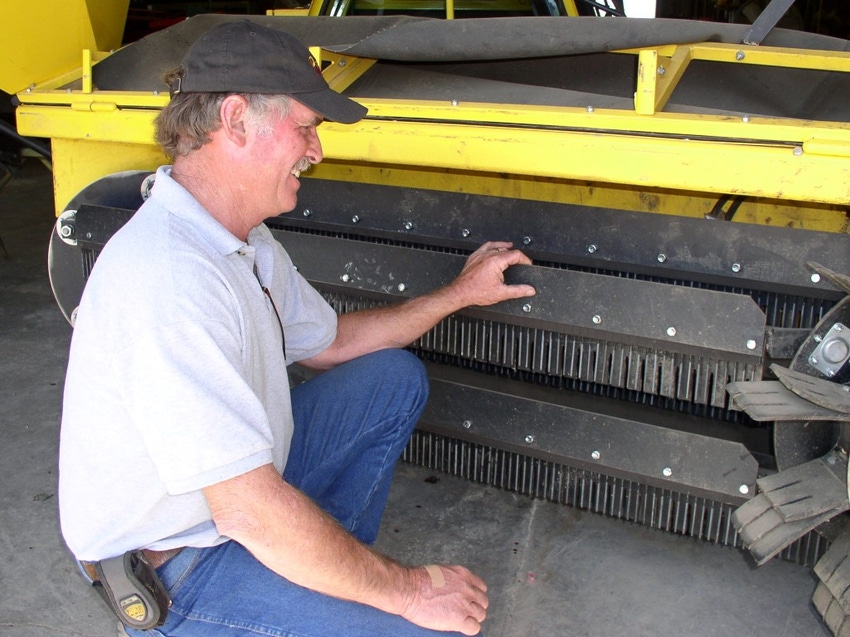
Almond growers, harvesters should plan ahead to minimize dust impact on neighbors, community
Recent findings from the California Almond Sustainability Program indicate that most growers are reducing dust at harvest.Dust reduction is tied to training equipment operators in preventive tactics and using sweepers designed to minimize dust.
April 21, 2015

As the California drought continues, complaints about visible dust from almond harvest have been on the rise in the local media and from local air quality agencies. The growing importance of almonds in California means increased responsibility and scrutiny.
In addition, with the extremely dry conditions, there is little moisture to aid in reducing dust. Almond growers need to ensure they are doing all they can do to minimize the generation of dust at harvest.
While there are no direct regulations applicable to almond harvesting operations, San Joaquin Air District Rule 4102, known as the nuisance rule, says almond growers can still be implicated for excessive visible dust generation.
It is also important to the overall perception of the almond industry for growers to consider the impact on neighbors, workers, and anyone else near an orchard under harvest.
Growers reducing dust levels
Recent findings from the California Almond Sustainability Program indicate that the majority of growers are reducing dust at harvest by training equipment operators in preventive tactics and using sweepers designed to minimize dust.
Findings also show that, as a group, almond growers can do even more to minimize dust and associated PM10 from harvest operations by lowering separator fan speeds in conventional pickup machines, or further embracing the use of pickup machines designed to reduce dust generation.
Tactical approaches to dust reduction
Almond Board–funded research over the years has helped develop specific strategies for reducing dust and PM10 at harvest.
Among these tactics include:
Set sweeper heads to optimum level - Sweeper heads should be set at the manufacturer’s factory level so that wire tines are 0.125 inch off the ground. If set too low, dust from the pickup is increased substantially.
Additionally, if harvesting in hilly terrain, take inclines into consideration when setting sweeper head height.
Use wire tines on sweeper heads - Wire tines without rubber flaps on sweeper heads can reduce dust, particularly on softer soils.
Reduce blower passes where possible - Making three blower passes doubles the amount of dust released from the orchard during harvest, compared to making a single blower pass. Adjusting blower spouts to match field conditions and/or adding an optional berm brush can reduce passes.
Reduce harvester ground speed - Slower pickup speeds of 1.5 miles per hour (mph) cut dust emissions by 50 percent compared to speeds of 3 mph. Gauge speed reduction to match orchard conditions.
In orchards with loose soils, slower ground speed allows gravity to drop dirt, reducing the reliance on fans to do it.
Lower separator fan speed - Reduce separator fan speeds to the extent possible.
Blow into the orchard when working near field edges - When operating near roads or homes during harvest, use the trees and their canopies to naturally filter dust. Blowing rows close to the edge into the orchard allows dust to filter and settle out.
Maintain a clean orchard floor - Under these conditions, suction fan speed can be reduced on pickup machines to dramatically reduce dust in the field without loss of harvest efficiency.
Additionally, maintaining a clean orchard floor increases the efficacy of each of the previously mentioned strategies.
Talk with your custom harvester
Growers who rely on custom harvesters to manage harvest operations should discuss these strategies and the importance of protecting the reputation of the almond industry by taking all steps possible to keep visible dust to a minimum during harvest, even if it means it might take more time to harvest.
Growers and their custom harvesters can adapt equipment, ensure proper training of equipment operators, and implement simple strategies to minimize dust and PM10s.
In doing so, they can often decrease fuel and labor costs, and at the same time, following these steps can go a long way toward showing good faith with their neighbors.
For more information, visit the www.Almonds.com/HarvestDust website.
You May Also Like



